UK Label Quick Reference
In my opinon, the old Parlophone pressings were some of the best pressed records during the era of vinyl. Their deep grooves and heavy weight construction ensured years of great playback and fidelity even with ample play time (i.e., scuffs and scratches). I am constantly amazed at how quiet a VG condition Parlophone LP will play. From a collectors perspective there is a lot to know about the Parlophone pressings. My intent is to get you familiar with the labels so you have a point of reference and then you can click the links below or search the web if you wish to explore some more. Parlophone record numbers starting with PMC are mono and PCS are stereo pressings (PMCO and PCSO respectively for Australian (OZ) pressings). Also a matrix beginning with XEX is a mono recording and YEX denotes stereo. The matrix can be found at the 6 o'clock position in the dead wax (area between the end of the last song and the beginning of the label).
|

1 - Famous Black & Gold Label - OZ Version |

2 - Y&B 3rd Pressing w/o Published in 1963 Text |

3 - Y&B 4th Pressing w/Published in 1963 Text |

4 - Rare 1 Box EMI "CBS" Pressing |

5 - 1980s "Retro" Yellow & Black Label |

6 - 2 Box EMI - Standard Re-issue Label |
Some Beatles LPs are considered highly collectible. One is the Butcher Album, others are an orginal UK White Album recorded in mono and Please Please Me on the Parlophone "Black & Gold" label. Picture #1 above (top left) is the Australian (OZ) version of the Black & Gold label. Almost identical to its UK counterpart, this is the very first Parlophone label that introduced the Beatles to the world. Although the mono version (pictured) is very collectible, the stereo version is even more so. This is because stereo pressings were not the norm back in the early '60's. If you have a stereo Black & Gold, you have a highly collectible record. The Black & Gold label had a short Beatle life span and soon after the first pressings of Please Please Me Parlophone revamped the label to what is commonly known as the Yellow & Black (Y&B) label.
Below is a description of the above labels:
Label #1 - Australian (OZ) mono version of the Black & Gold label.
Label #2 - First Yellow & Black (Y&B) pressing was the 3rd pressing of Please Please Me. A 3rd pressing can be identified by the exclusion of "Recording First Published 1963" to the left of the spindle hole.
Label #3 - Y&B 4th pressing. This pressing includes "Recording First Published 1963" to the left of the spindle hole.
Label #4 - In 1969, Parlophone had a transition label that is commonly referred to as the "1 Box EMI" label (scan #4). So named because the EMI logo at the bottom of the label is framed in a box. These were high quality, thick vinyl pressings with great fidelity, much like its Y&B predecessor. This label was pressed for only one year and has its niche collector community. The label pictured above is the rarer "CBS" label which is denoted by the inner rim inside the label. When Parlophone required increased production and did not have capacity, they (like Capitol) subcontracted to other record companies such as Decca or CBS.
Label #5 - Y&B re-issue from the 1980's. At first glance it looks identical to an original Y&B label. Three quick ways to tell the difference is: 1) the word "mono" is printed above "O" in the word Parlophone (large yellow print), 2) the rim print on the re-issue does not include the wording "The Parlophone Co, LTD..." or the "The Gramophone Co, LTD..." which would be located at the beginning of the silver rim text on the left hand side of the label, and 3) re-issues exclude the "Made In Great Britain" print at the bottom of the label. Be aware that stereo re-issues on this label also have the word "stereo" above the "O" but so did the original pressings! There are quite a number of the re-issues selling online. Be sure to scrutinize the details before bidding or buying because you can easily end up buying a re-issue when you were hunting for an original/early Y&B pressing.
Label #6 - The last label is the "2 Box EMI" label. This label is commonly associated with all Parlophone Beatle UK re-issues and the least collectible.
Early Parlophone LPs contained the wording "The Parlophone Co, LTD..." in silver print along the left hand side of the label. In 1965, Parlophone replaced this wording with "The Gramophone Co, LTD...". Early Parlophone Beatles LPs that contain the "The Parlophone Co, LTD..." are: Please Please Me, With The Beatles, A Hard Days Night and Beatles For Sale (the Beatles' first four UK records). Starting with Help!, the wording was changed to "The Gramophone Co, LTD...". Any of the first four LPs with the "Gramophone" text instead of "Parlophone" are later pressings and not worth as much as their earlier counterparts. Starting with Help! you will not see the "Parlophone" wording. Here is an illustration:
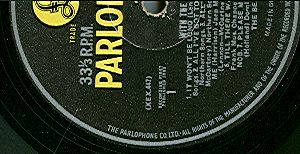
Original/early Beatle UK pressings will contain the "ParlophoneCo, LTD..." in silver text along the label rim.
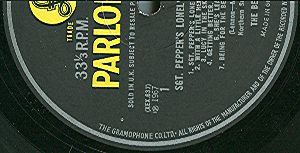
Starting with Help! (1965) all Parlophone Y&B will show the "Gramophone" text.
Starting in 1964, Parlophone added the verbiage "Sold in the UK Subject To Resale Price Conditions, See Price Lists" above the spindle hole. Only early pressings of the Beatles first two albums, Please Please Me and With The Beatles excluded this wording. Later pressings of these two LPs and subsequent Beatle LP releases all included this text (through 1968). Here is an example:
 _
_
Note the "Subject To Resale..." wording above the spindle hole on the Sgt Pepper (scan on the left) and the exclusion of the wording on the early Please Please Me. Starting with the 5th pressing of Please Please Me and the 3rd pressing of With The Beatles, all future pressings and releases contained the "Subject To Resale..." wording.
Last discussion point will deal with the Parlophone "martix", "mother stamps" and "tax codes". I have yet to come across a concrete explanation of whether the last digit in a Parlophone matrix represents or is analogous to a pressing number. For example, the matrix which is located in the dead wax (the section of vinyl between the last song and the beginning of the label) at the 6 o'clock position has the following format for a mono pressing: XEX-###-#. The first three alpha characters identify whether the record in mono (XEX) or stereo (YEX). The next three numerics identify the record (e.g., Sgt. Pepper is 638) and the last numeric most assume is the pressing (for example, Sgt. Pepper mono is XEX-638-1). However, the last number is baffling because some Beatle records like Pepper and Please Please Me always end in -1 when other Beatle records have -1, -2, -3 and so on. I opened this question up to the Beatle forum at the Record Collectors Guild (many years ago) and the answers were inconclusive. There were two theories from resident Beatle expert "BeatleHarb":
"...the matrix numbers (to my knowledge) were altered whenever something to do with the contents were changed. This is why XEX 606-1 was changed to XEX 606-2 when Tomorrow Never Knows was altered. Also when Loud Cut pressings of Rubber Soul went from -1 to -4 to correct the tracks", or...
"...another theory could be that the matrix number was increased whenever the LP master tapes had to be brought out to create a new set of mother plates for the vinyl. That would explain why on some pressings (i.e. With the Beatles) the songs never change but the matrix numbers still rise.".
Both these theories are logical, but because Sgt Pepper and Please Please Me always end in -1, the mystery lives on. I have concluded it appears that the last digit in the matrix is somewhat analogous to a pressing for most Parlophone Beatle record with the exception of Pepper and PPM. Therefore, it is safe to state: the closer the last digit in the matrix is to "1" (with -1 being optimal) the earlier the pressing (again with the exception of Sgt Pepper and Please Please Me).
In order to really determine how early a pressing you have, especially with the two aformentioned anomolies, you need to also investigate the tax codes and stampers (which includes the mother plate code at the 9 o'clock position and the pressing stamper code at 3 o'clock. The stamper letter code is believed to have changed every 300 presses and used the letters GRAMOPHLTD (Gramophone Ltd) where G=1, R=2, A=3, M=4, O=5, P=6, H=7, L=8, T=9 and D=0. If you can find a Beatles LP with the codes 1/G then it's one of the first 300 off the press!
For a better understanding of "tax codes" and "stampers" head over to The Beatles Collection and The Beatles Records Collection.
Here are some additional links for research and reference:
Identify & Date Your Beatles Parlophone Records | Australian Parlophone Beatles Albums | Beatle Counterfeit Records - Before Capitol | Beatles Singles and EP Discography | About The Butcher Cover | Beatle Autographs | More Parlophone Information
Top of Page
© 2022 M. Williams - All Rights Reserved




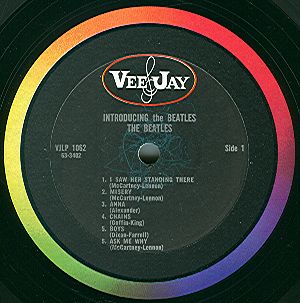



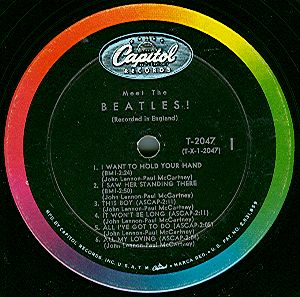





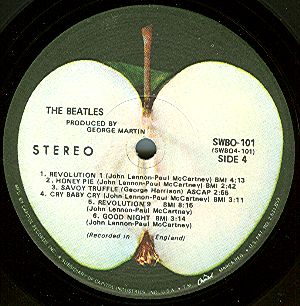

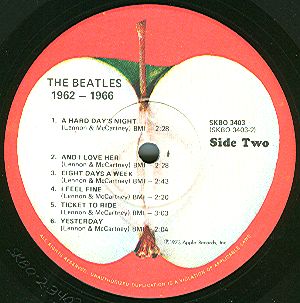












 _
_